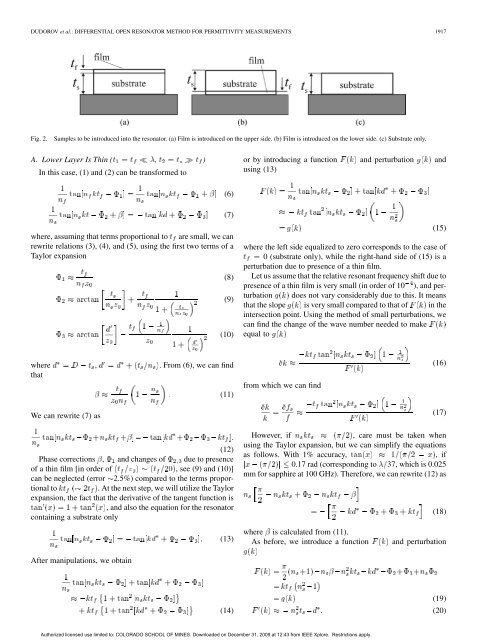Differential Open Resonator Method for Permittivity Measurements ...
Differential Open Resonator Method for Permittivity Measurements ...
Differential Open Resonator Method for Permittivity Measurements ...
Create successful ePaper yourself
Turn your PDF publications into a flip-book with our unique Google optimized e-Paper software.
DUDOROV et al.: DIFFERENTIAL OPEN RESONATOR METHOD FOR PERMITTIVITY MEASUREMENTS 1917Fig. 2.Samples to be introduced into the resonator. (a) Film is introduced on the upper side. (b) Film is introduced on the lower side. (c) Substrate only.A. Lower Layer Is Thin ( , )In this case, (1) and (2) can be trans<strong>for</strong>med toor by introducing a function and perturbation andusing (13)(6)where, assuming that terms proportional to are small, we canrewrite relations (3), (4), and (5), using the first two terms of aTaylor expansion(7)(8)(9)(10)(15)where the left side equalized to zero corresponds to the case of0 (substrate only), while the right-hand side of (15) is aperturbation due to presence of a thin film.Let us assume that the relative resonant frequency shift due topresence of a thin film is very small (in order of 10 ), and perturbationdoes not vary considerably due to this. It meansthat the slope is very small compared to that of in theintersection point. Using the method of small perturbations, wecan find the change of the wave number needed to makeequal towhere , . From (6), we can findthatWe can rewrite (7) as(11)from which we can find(16)(17)(12)Phase corrections , and changes of due to presenceof a thin film [in order of , see (9) and (10)]can be neglected (error 2.5%) compared to the terms proportionalto. At the next step, we will utilize the Taylorexpansion, the fact that the derivative of the tangent function is, and also the equation <strong>for</strong> the resonatorcontaining a substrate only(13)However, if, care must be taken whenusing the Taylor expansion, but we can simplify the equationsas follows. With 1% accuracy,,if0.17 rad (corresponding to 37, which is 0.025mm <strong>for</strong> sapphire at 100 GHz). There<strong>for</strong>e, we can rewrite (12) aswhere is calculated from (11).As be<strong>for</strong>e, we introduce a function(18)and perturbationAfter manipulations, we obtain(14)(19)(20)Authorized licensed use limited to: COLORADO SCHOOL OF MINES. Downloaded on December 31, 2009 at 12:43 from IEEE Xplore. Restrictions apply.
















